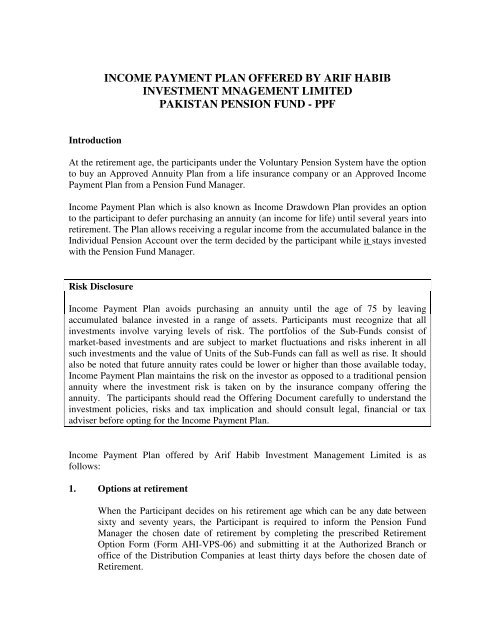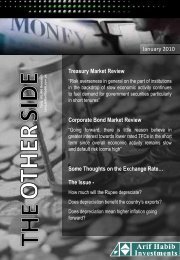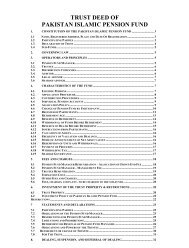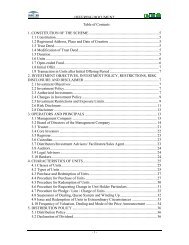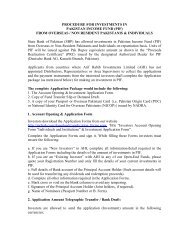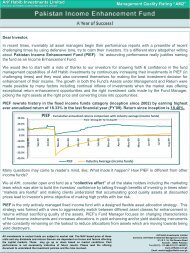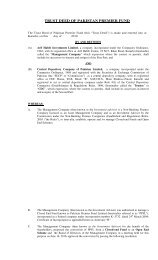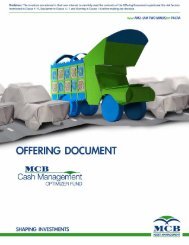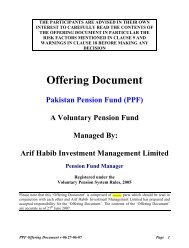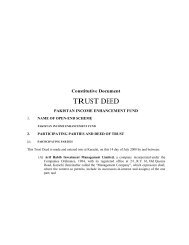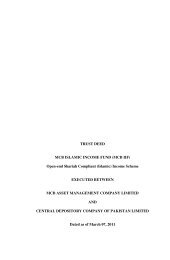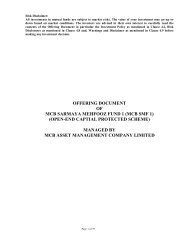Income Payment Plan - MCB-Arif Habib Savings and Investments ...
Income Payment Plan - MCB-Arif Habib Savings and Investments ...
Income Payment Plan - MCB-Arif Habib Savings and Investments ...
Create successful ePaper yourself
Turn your PDF publications into a flip-book with our unique Google optimized e-Paper software.
INCOME PAYMENT PLAN OFFERED BY ARIF HABIB<br />
INVESTMENT MNAGEMENT LIMITED<br />
PAKISTAN PENSION FUND - PPF<br />
Introduction<br />
At the retirement age, the participants under the Voluntary Pension System have the option<br />
to buy an Approved Annuity <strong>Plan</strong> from a life insurance company or an Approved <strong>Income</strong><br />
<strong>Payment</strong> <strong>Plan</strong> from a Pension Fund Manager.<br />
<strong>Income</strong> <strong>Payment</strong> <strong>Plan</strong> which is also known as <strong>Income</strong> Drawdown <strong>Plan</strong> provides an option<br />
to the participant to defer purchasing an annuity (an income for life) until several years into<br />
retirement. The <strong>Plan</strong> allows receiving a regular income from the accumulated balance in the<br />
Individual Pension Account over the term decided by the participant while it stays invested<br />
with the Pension Fund Manager.<br />
Risk Disclosure<br />
<strong>Income</strong> <strong>Payment</strong> <strong>Plan</strong> avoids purchasing an annuity until the age of 75 by leaving<br />
accumulated balance invested in a range of assets. Participants must recognize that all<br />
investments involve varying levels of risk. The portfolios of the Sub-Funds consist of<br />
market-based investments <strong>and</strong> are subject to market fluctuations <strong>and</strong> risks inherent in all<br />
such investments <strong>and</strong> the value of Units of the Sub-Funds can fall as well as rise. It should<br />
also be noted that future annuity rates could be lower or higher than those available today,<br />
<strong>Income</strong> <strong>Payment</strong> <strong>Plan</strong> maintains the risk on the investor as opposed to a traditional pension<br />
annuity where the investment risk is taken on by the insurance company offering the<br />
annuity. The participants should read the Offering Document carefully to underst<strong>and</strong> the<br />
investment policies, risks <strong>and</strong> tax implication <strong>and</strong> should consult legal, financial or tax<br />
adviser before opting for the <strong>Income</strong> <strong>Payment</strong> <strong>Plan</strong>.<br />
<strong>Income</strong> <strong>Payment</strong> <strong>Plan</strong> offered by <strong>Arif</strong> <strong>Habib</strong> Investment Management Limited is as<br />
follows:<br />
1. Options at retirement<br />
When the Participant decides on his retirement age which can be any date between<br />
sixty <strong>and</strong> seventy years, the Participant is required to inform the Pension Fund<br />
Manager the chosen date of retirement by completing the prescribed Retirement<br />
Option Form (Form AHI-VPS-06) <strong>and</strong> submitting it at the Authorized Branch or<br />
office of the Distribution Companies at least thirty days before the chosen date of<br />
Retirement.
Participants have the following options:<br />
(a) Withdraw up to 25% of the amount in his/her Individual Pension Account as<br />
cash, without being charged for tax on this amount<br />
(b) Use the remaining amount to purchase an Approved Annuity <strong>Plan</strong> from a life<br />
insurance company of his/her choice; or,<br />
(c) To enter in to an agreement with the Pension Fund Manager to withdraw from<br />
the remaining amount, monthly instalments till the age of 75 years or earlier,<br />
according to an <strong>Income</strong> <strong>Payment</strong> <strong>Plan</strong>, approved by the Commission.<br />
The scheme provides every Participant an option to withdraw as tax-free lump-sum<br />
up to 25% of the balance in the Individual Pension Account. However, the more<br />
cash is withdrawn as tax-free lump-sum, the lesser pension shall be available from<br />
the <strong>Income</strong> <strong>Payment</strong> <strong>Plan</strong> during retirement <strong>and</strong> vice versa. Further it is not<br />
necessarily that every Participant needs full 25% of cash lump-sum at retirement.<br />
Lower the amount of lump-sum withdrawn, higher will be the pension payments.<br />
Furthermore the tax rate applicable on pension payment is likely to be lower than<br />
the tax rate on full income prior to retirement.<br />
2. Eligibility<br />
A Participant would be eligible to opt for an <strong>Income</strong> <strong>Payment</strong> <strong>Plan</strong>, at any time,<br />
after achieving the retirement age, as referred in clause (c) of Para 1 above.<br />
However, the participant can not opt for the <strong>Income</strong> <strong>Payment</strong> <strong>Plan</strong> if he has already<br />
purchased an Approved Annuity <strong>Plan</strong> from a life insurance company.<br />
3. Features <strong>and</strong> Mechanics of the <strong>Income</strong> <strong>Payment</strong> <strong>Plan</strong><br />
When the Participant decides to start taking pension benefits, the participant first<br />
decides whether he/she wants to take a tax free cash sum. If the Participant decides<br />
to draw tax free cash, the sum of cash is transferred to the respective bank account<br />
of the participant <strong>and</strong> the balance amount breaks down into two parts: i.e. Part-A<br />
<strong>and</strong> Part-B:<br />
Part A: Invests in the approved PPF Debt Sub-Fund that targets to earn at least<br />
inflation, to provide a regular <strong>and</strong> stable real income (purchasing power)<br />
every month throughout drawdown period.<br />
A portion of Part-A which will be used to pay current year monthly<br />
pensions, will be invested in the approved PPF Money-Market Sub-<br />
Fund to further reduce volatility.
The portion of the Individual Pension Account to be placed in Part A will<br />
be calculated as follows:<br />
Part A = Accumulated Balance * (Age till Termination of IPP less retirement age)<br />
Years to live after retirement (Assumed as per average Life Expectancy)<br />
For this purpose the insurance company assumes a life-expectancy of 85<br />
years for an individual aged 75 (willing to purchase an annuity).<br />
Each month a payment is withdrawn from this accumulated balance (in<br />
PPF Money Market Fund) according to the following formula:<br />
Pension <strong>Payment</strong> = accumulated balance at beginning of the month<br />
No. of drawdown payments remaining for the year<br />
Two things are evident from this formula:<br />
This would ensure that Part A reduces to zero by the end of the drawdown<br />
period <strong>and</strong> not before that. At end of the Drawdown period, an Approved<br />
Annuity <strong>Plan</strong> will be purchased with the balance in Part B.<br />
Monthly Pension will not remain constant throughout, instead is expected to<br />
increase each month due to the investment income earned on money market<br />
investments.<br />
Monthly <strong>Payment</strong>s under the <strong>Income</strong> <strong>Payment</strong> <strong>Plan</strong> shall be subject to tax at<br />
the then tax rates applicable to that individual.<br />
Part B: Invests in the approved PPF Equity Sub-Fund <strong>and</strong> PPF Debt Sub-Fund<br />
till termination of <strong>Income</strong> <strong>Payment</strong> <strong>Plan</strong>. At the time of termination of<br />
<strong>Income</strong> <strong>Payment</strong> <strong>Plan</strong>, total balance in this Part shall be used to purchase<br />
an Approved Annuity <strong>Plan</strong> from an insurance company of the Participant’s<br />
choice.<br />
The portion of accumulated balance to be placed in Part B will be<br />
calculated as follows:<br />
Part B = Accumulated Balance* (Years to live after retirement less age till termination of IPP)<br />
Years to live after retirement (Assumed as per average life expectancy)
The portion of accumulated balance Placed in Part-B will be invested in both the<br />
approved PPF Equity Sub-Fund <strong>and</strong> PPF Debt Sub-Fund as per the following<br />
table:<br />
Part B – Allocation Scheme<br />
Years to termination of <strong>Income</strong> <strong>Payment</strong> <strong>Plan</strong> are complete years to termination<br />
of <strong>Income</strong> <strong>Payment</strong> <strong>Plan</strong> at any date. So 3.1 or 2.9 years would be considered 3<br />
years for the purpose.<br />
Years to termination of<br />
<strong>Income</strong> <strong>Payment</strong> <strong>Plan</strong><br />
% of Part B invested<br />
in<br />
PPF Equity Sub-Fund<br />
% of Part B<br />
invested in<br />
PPF Debt Sub-Fund<br />
10 or more 100% 0%<br />
9 90% 10%<br />
8 80% 20%<br />
7 70% 30%<br />
6 55% 45%<br />
5 40% 60%<br />
4 30% 70%<br />
3 20% 80%<br />
2 10% 90%<br />
1 0% 100%<br />
This table illustrates percentages set at different durations of <strong>Income</strong> <strong>Payment</strong> <strong>Plan</strong>.<br />
However, the risk that Part B over the period invested does not rise in value as<br />
much as expected which may lead to lower real monthly annuity compared to<br />
the last withdrawn monthly pension from the <strong>Income</strong> <strong>Payment</strong> <strong>Plan</strong>.<br />
4. <strong>Payment</strong> of Pension<br />
Drawing from the <strong>Income</strong> <strong>Payment</strong> <strong>Plan</strong> will commence after completing one<br />
month in the <strong>Plan</strong>. The payment will be made on the 25 th day of every month, (or<br />
the first working day following that in the event the 25 th is a closed day). AHIM will<br />
issue the instructions to the Trustee to credit the amount to the Participants<br />
designated banker.<br />
Monthly payments under the <strong>Income</strong> <strong>Payment</strong> <strong>Plan</strong> shall not be in excess of the<br />
amount calculated through formulas mentioned in para (3) above.<br />
5. Investment Policy<br />
Investment in sub-funds will be made in accordance with the Investment Policy<br />
prescribed by the Commission from time to time.
6. Fees <strong>and</strong> Charges<br />
Fees <strong>and</strong> Charges will be charged in line with the provisions of the Trust Deed. The<br />
Commission may review the fees specified from time to time <strong>and</strong> any change shall<br />
also be applicable to the <strong>Income</strong> <strong>Payment</strong> <strong>Plan</strong>.<br />
7. The advantages <strong>and</strong> disadvantages of Conventional Annuities <strong>and</strong> <strong>Income</strong><br />
<strong>Payment</strong> <strong>Plan</strong>s:<br />
Advantages <strong>and</strong> disadvantages of annuities <strong>and</strong> <strong>Income</strong> <strong>Payment</strong> <strong>Plan</strong> are as under:-<br />
Advantages of the Conventional Annuities:<br />
Simple, easy to underst<strong>and</strong><br />
Once set up, income is fixed <strong>and</strong> secure<br />
The income will never run out, however long an individual is alive<br />
Available for funds of all sizes<br />
No ongoing reviews required<br />
No investment risk: not affected by stock market falls, or economic slumps<br />
Disadvantages of the Conventional Annuities:<br />
Can be inflexible<br />
Cannot be changed<br />
An annuity (without value protection) cannot generally be passed on to the<br />
successors as a lump sum<br />
Current annuity plans do not offer any inflation protection<br />
Current annuity rates are perceived to be low<br />
Spouse’s benefits must be set up at outset – so can be wasted on divorce or if<br />
spouse dies first<br />
Not affected by stock market rises<br />
Advantages of the <strong>Income</strong> <strong>Payment</strong> <strong>Plan</strong> (unsecured Pension) before age 75<br />
<br />
An individual does not have to make a one-off decision<br />
Individual retains investment choice <strong>and</strong> control<br />
Can potentially pass the unutilized fund in lump-sum on to the successors (less<br />
tax where applicable)<br />
More flexible
An individual can plan the income he receives to match his requirements<br />
Participants achieve their lifestyle through the monthly withdrawals in an<br />
increasing pattern attempting to keep up with rising inflation<br />
Potential for growth <strong>and</strong> increasing income<br />
Disadvantages of the <strong>Income</strong> <strong>Payment</strong> <strong>Plan</strong> (unsecured Pension) before age 75:<br />
More complex, an individual may need advice<br />
Requires regular review<br />
8. Death of the participant<br />
In case of death of a participant before the completion of the <strong>Income</strong> <strong>Payment</strong><br />
<strong>Plan</strong>, all the units of the sub-funds in Part A <strong>and</strong> Part B to his credit shall be<br />
redeemed at the net asset value notified at close of the day of intimation of death<br />
<strong>and</strong> the amount due shall be credited to his Individual Pension A ccount, which shall<br />
earn the applicable market rate of interest for such deposits.<br />
The total amount in the Individual Pension Account of the deceased participant<br />
shall be divided among the nominated survivors according to the percentages<br />
specified in the nomination deed <strong>and</strong> each of the nominated survivor shall then<br />
have the following options, namely :-<br />
(a) withdraw his share of the amount subject to the conditions laid down in the<br />
<strong>Income</strong> Tax Ordinance 2001 (XLIX of 2001);<br />
(b) transfer his share of the amount into his existing or new individual pension<br />
account to be opened with the Pension Fund Manager, according to VPS<br />
Rules;<br />
(c) use his share of the amount to purchase an annuity on his life from a Life<br />
Insurance Company, only if the age of the survivor is fifty- five years or more;<br />
(d) use his share of the amount to purchase a deferred annuity on his life from a<br />
Life Insurance Company to commence at age fifty- five years or later.
9. Nominee<br />
The individual participant may designate <strong>and</strong> also change the Nominee under the<br />
<strong>Income</strong> <strong>Payment</strong> <strong>Plan</strong>. In registering a nomination, the Pension Fund Manager does<br />
not accept any responsibility as to its validity, legal effect or meaning.<br />
10. Term of the <strong>Income</strong> <strong>Payment</strong> <strong>Plan</strong><br />
There is no maximum term for the <strong>Income</strong> <strong>Payment</strong> <strong>Plan</strong> as long as the plan<br />
terminates at or before age 75, at which point the individual has to purchase an<br />
annuity or withdraw the funds after paying tax on them. <strong>Plan</strong> must however be of at<br />
least one complete year.<br />
11. Transfer of Funds under <strong>Income</strong> <strong>Payment</strong> <strong>Plan</strong><br />
The Participants have the options during the tenure of the <strong>Income</strong> <strong>Payment</strong> <strong>Plan</strong> to<br />
transfer the remaining balance (Part A & Part B) to another Pension Fund Manager<br />
or life insurance company to purchase an Approved <strong>Income</strong> <strong>Payment</strong> <strong>Plan</strong> or an<br />
Approved Annuity <strong>Plan</strong> respectively. No fee will be charged to participants in case<br />
of incoming transfers into the <strong>Income</strong> <strong>Payment</strong> <strong>Plan</strong>.<br />
12. Winding Up<br />
In the event of winding up of the Pakistan Pension Fund the units st<strong>and</strong>ing to the<br />
credit of the Participants will be dealt with in the light of VPS Rules, 2005 <strong>and</strong><br />
Trust Deed.<br />
13. Validity of the Terms of the <strong>Income</strong> <strong>Payment</strong> <strong>Plan</strong><br />
Should there be any changes in the <strong>Income</strong> Tax Ordinance or due to any directive<br />
given by the Commission under the Voluntary Pension System Rules in respect of<br />
the <strong>Income</strong> <strong>Payment</strong> <strong>Plan</strong>, the Pension Fund Manager may vary the benefits <strong>and</strong><br />
conditions as directed by the Commission. Notice in writing of any such variation<br />
shall be sent to last address of the individual recorded by the Pension Fund<br />
Manager.<br />
14. Approval<br />
The <strong>Income</strong> <strong>Payment</strong> <strong>Plan</strong> of <strong>Arif</strong> <strong>Habib</strong> Investment Management Limited has been<br />
approved by the Commission.<br />
However, it must be distinctly understood that such Approval or authorisation<br />
neither implies official recommendation by the Commission to contribute into<br />
the Pension Fund nor does the Commission take any responsibility for the<br />
financial soundness of the <strong>Income</strong> <strong>Payment</strong> <strong>Plan</strong> offered by <strong>Arif</strong> <strong>Habib</strong><br />
Investment Management Limited.
15. Risk disclosure<br />
The Sub-Fund(s) target return cannot be guaranteed. The portfolio of the Sub-<br />
Fund(s) is subject to market fluctuations <strong>and</strong> risk inherent in all such<br />
investments. It should be noted that the value/price of Units of the Sub-Funds can fall<br />
\as well as rise.<br />
<strong>Income</strong> drawdown will reduce the size of accumulated balance <strong>and</strong> the<br />
investment growth may not be sufficient to maintain the level of income. The<br />
level of income taken out may need to be reviewed if the balance amount<br />
becomes too small.<br />
Investment performance may be lower than the assumptions made.<br />
The income received may be lower or higher than the amount that could have<br />
been received from an annuity, depending on the performance of investments.<br />
As annuity rates can change substantially <strong>and</strong> rapidly, there is no guarantee that<br />
at the time of purchasing an annuity, the rates will be favourable.<br />
The Units of Sub-Funds are not bank deposits <strong>and</strong> are neither issued by, insured<br />
by, or the obligation of the Commission, any Government agency, any of the<br />
shareholders or the Pension Fund Manager, or any other bank or financial<br />
institution.<br />
Conversely, purchasing a life annuity at retirement is advised in the following<br />
circumstances:<br />
The retiree expects to live longer than the average life expectancy assumed in<br />
annuity prices.<br />
The retiree is of the view that interest rates would fall in future.


